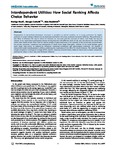Interdependent Utilities: How Social Ranking Affects Choice Behavior
| dc.contributor.author | Bault, Nadège | |
| dc.contributor.author | Coricelli, G | |
| dc.contributor.author | Rustichini, A | |
| dc.date.accessioned | 2020-01-09T14:11:46Z | |
| dc.date.available | 2020-01-09T14:11:46Z | |
| dc.date.issued | 2008-10-22 | |
| dc.identifier.issn | 1932-6203 | |
| dc.identifier.issn | 1932-6203 | |
| dc.identifier.other | ARTN e3477 | |
| dc.identifier.uri | http://hdl.handle.net/10026.1/15291 | |
| dc.description.abstract |
Organization in hierarchical dominance structures is prevalent in animal societies, so a strong preference for higher positions in social ranking is likely to be an important motivation of human social and economic behavior. This preference is also likely to influence the way in which we evaluate our outcome and the outcome of others, and finally the way we choose. In our experiment participants choose among lotteries with different levels of risk, and can observe the choice that others have made. Results show that the relative weight of gains and losses is the opposite in the private and social domain. For private outcomes, experience and anticipation of losses loom larger than gains, whereas in the social domain, gains loom larger than losses, as indexed by subjective emotional evaluations and physiological responses. We propose a theoretical model (interdependent utilities), predicting the implication of this effect for choice behavior. The relatively larger weight assigned to social gains strongly affects choices, inducing complementary behavior: faced with a weaker competitor, participants adopt a more risky and dominant behavior. | |
| dc.format.extent | e3477-e3477 | |
| dc.format.medium | Print-Electronic | |
| dc.language | en | |
| dc.language.iso | en | |
| dc.publisher | Public Library of Science (PLoS) | |
| dc.subject | Choice Behavior | |
| dc.subject | Gambling | |
| dc.subject | Humans | |
| dc.subject | Models, Theoretical | |
| dc.subject | Risk | |
| dc.subject | Social Class | |
| dc.title | Interdependent Utilities: How Social Ranking Affects Choice Behavior | |
| dc.type | journal-article | |
| dc.type | Journal Article | |
| dc.type | Research Support, Non-U.S. Gov't | |
| plymouth.author-url | https://www.webofscience.com/api/gateway?GWVersion=2&SrcApp=PARTNER_APP&SrcAuth=LinksAMR&KeyUT=WOS:000265126100008&DestLinkType=FullRecord&DestApp=ALL_WOS&UsrCustomerID=11bb513d99f797142bcfeffcc58ea008 | |
| plymouth.issue | 10 | |
| plymouth.volume | 3 | |
| plymouth.publication-status | Published online | |
| plymouth.journal | PLoS ONE | |
| dc.identifier.doi | 10.1371/journal.pone.0003477 | |
| plymouth.organisational-group | /Plymouth | |
| plymouth.organisational-group | /Plymouth/Faculty of Health | |
| plymouth.organisational-group | /Plymouth/Faculty of Health/School of Psychology | |
| plymouth.organisational-group | /Plymouth/REF 2021 Researchers by UoA | |
| plymouth.organisational-group | /Plymouth/REF 2021 Researchers by UoA/UoA04 Psychology, Psychiatry and Neuroscience | |
| plymouth.organisational-group | /Plymouth/Users by role | |
| plymouth.organisational-group | /Plymouth/Users by role/Academics | |
| dc.publisher.place | United States | |
| dcterms.dateAccepted | 2008-09-23 | |
| dc.identifier.eissn | 1932-6203 | |
| dc.rights.embargoperiod | Not known | |
| rioxxterms.versionofrecord | 10.1371/journal.pone.0003477 | |
| rioxxterms.licenseref.uri | http://www.rioxx.net/licenses/all-rights-reserved | |
| rioxxterms.licenseref.startdate | 2008-10-22 | |
| rioxxterms.type | Journal Article/Review |


